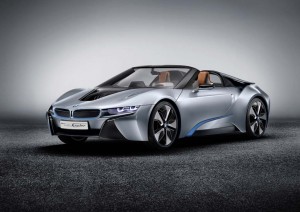Who says battery cars have to be dull and boring? BMW is determined to prove that electric propulsion can charge up buyers as it prepares to roll out its all-new sub-brand, BMW i.
The maker has already confirmed plans to stock the new marque’s showrooms with two models: the i3 battery-electric city car and the i8 plug-in hybrid. As TheDetroitBureau.com previously reported, we can anticipate several more models to follow – possibly including one based on the open-air prototype, the i8 Concept Spyder.
Significantly, the maker refers to it as “the third BMW i model,” which would suggest that it will soon drop the “concept” designation and roll out a production version.
The basics of the Concept Spyder are quite similar to those of the i8 Coupe, the battery-car built around BMW’s innovative LifeDrive architecture, which uses a mix of aluminum and carbon-fiber-reinforced plastic compounds to hold down weight, increase range and fuel economy and improve handling.
To put things into perspective, the i8 Concept Spyder comes in a bit under 3,600 pounds. By comparison, the similarly sized Fisker Karma tips the scales at closer to 5,300 lbs.
The drivetrain on the 2+2 convertible uses a 131 horsepower motor on the front axle, while a twin-turbo 3-cylinder gas engine drives the rear wheels, making 223 hp – for a combined 354 hp and 550 Newton meters of torque. That’s enough to launch the i8 Concept Spyder from 0 to 100 kmh in 5.0 seconds, with top speed rated at 155 mph.
But in the European test cycle the i8 Concept Spyder reportedly gets about 75 mpg. Its lithium-ion battery pack, meanwhile, stores enough power for about 19 miles per charge.
The front and rear axle modules are linked by an “energy tunnel” which houses the i8 Concept Spyder’s battery, further improving weight balance. The i8 drive system can send power through the front, rear or both axles simultaneously.
BMW says that when using a 220-volt charger a fully drained battery pack can be back to 100% in about two hours.
The new BMW i brand will launch production in 2014 at the maker’s newly expanded assembly plant in Leipzig, Germany.

